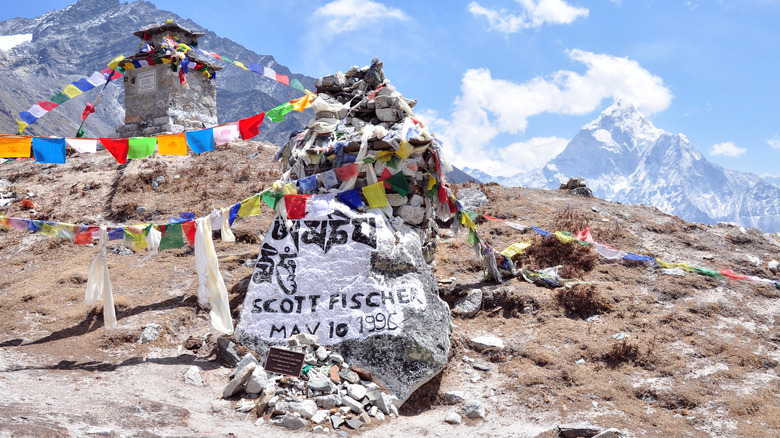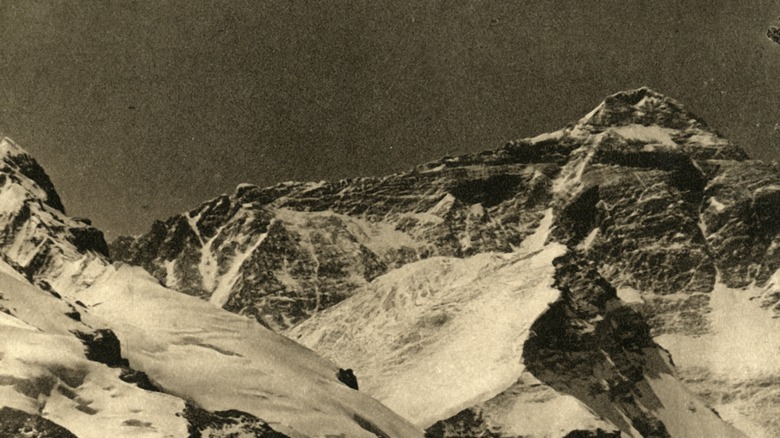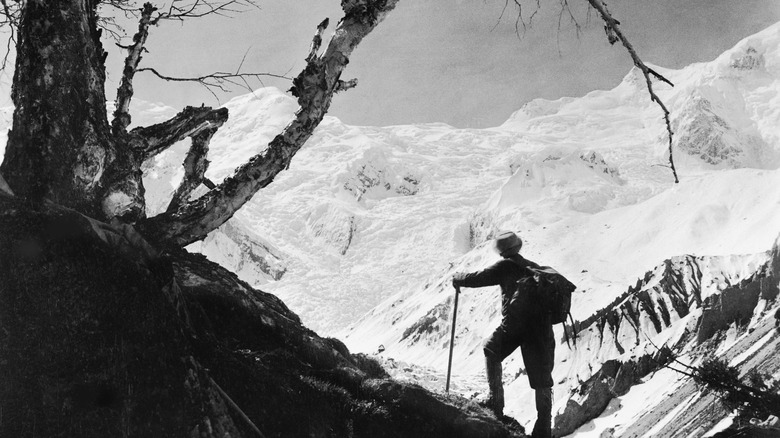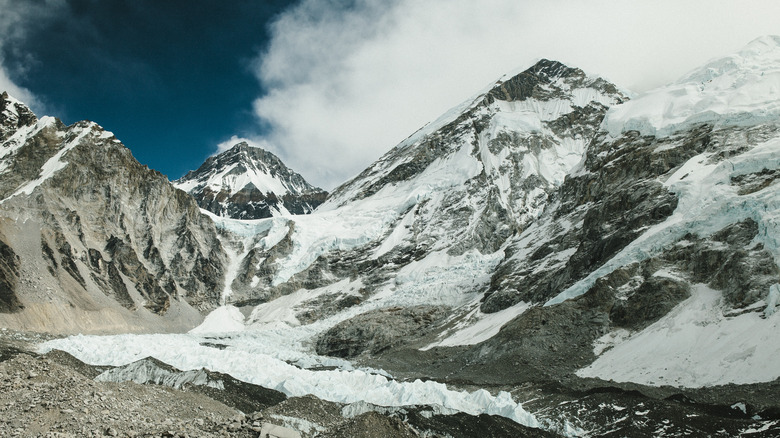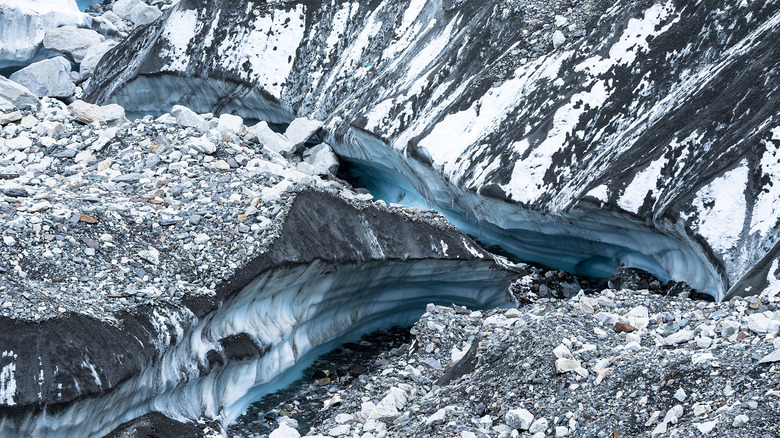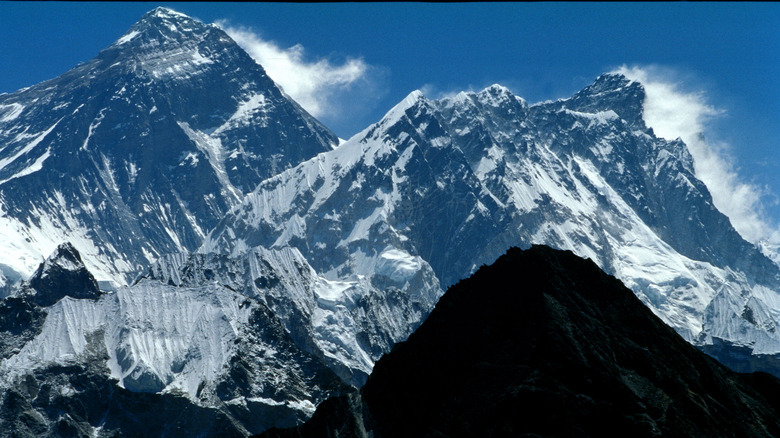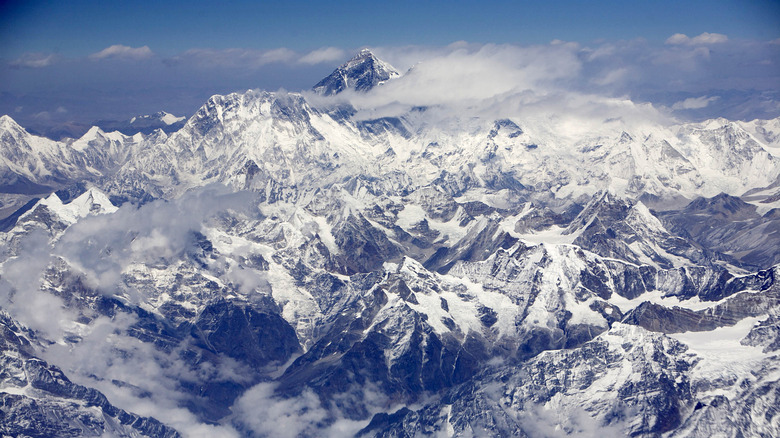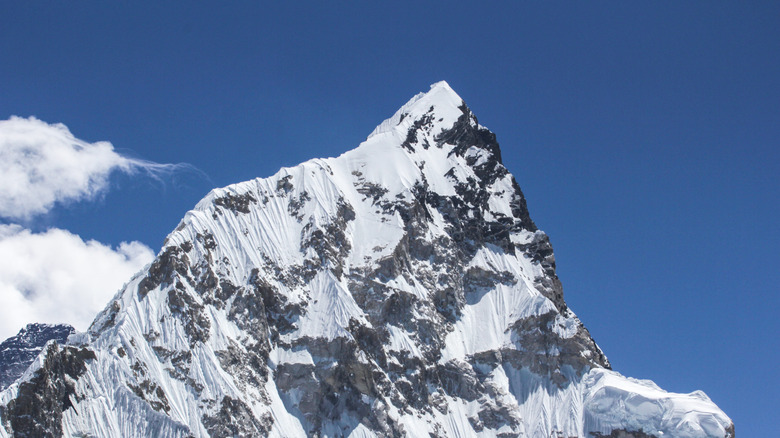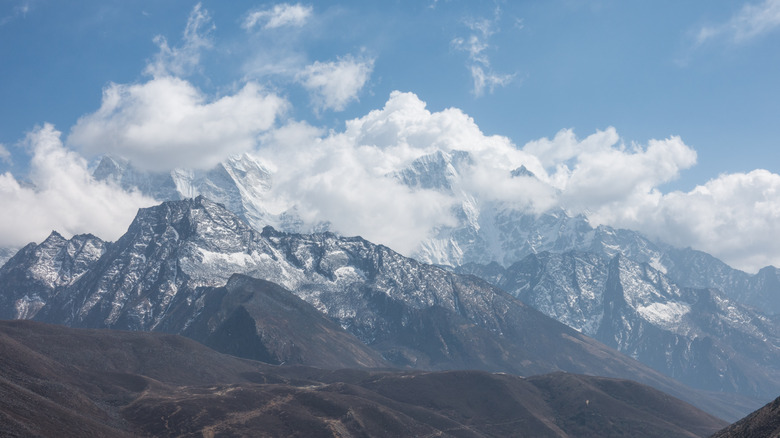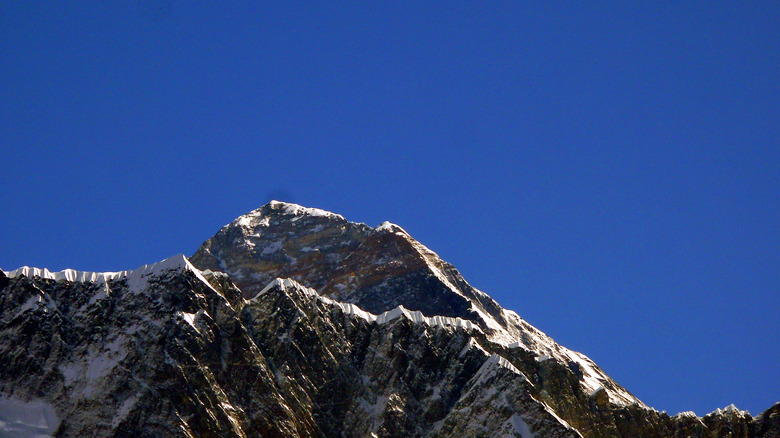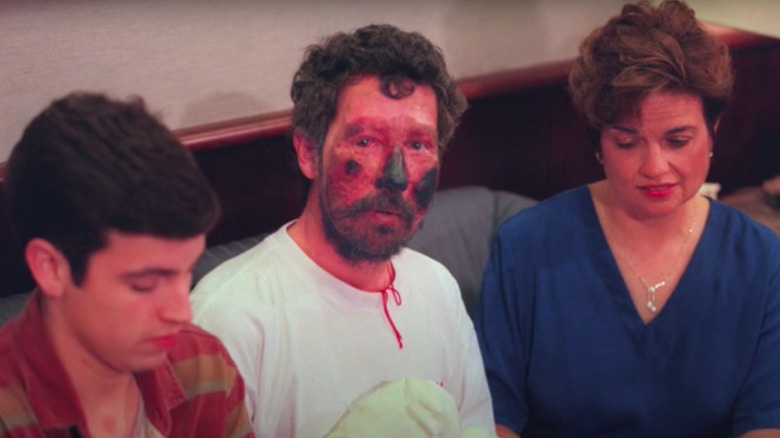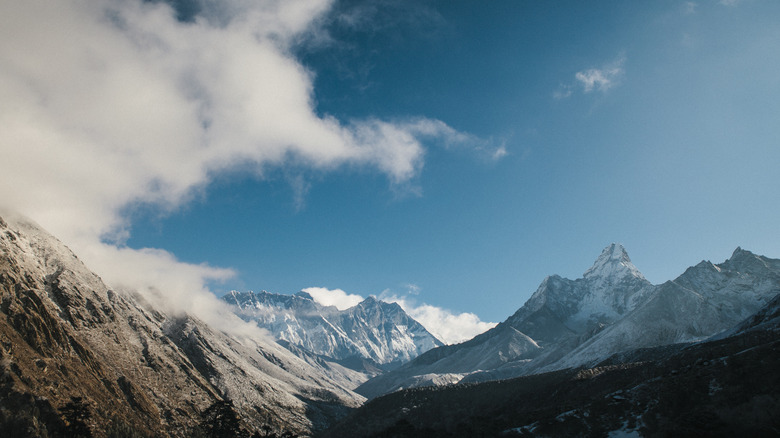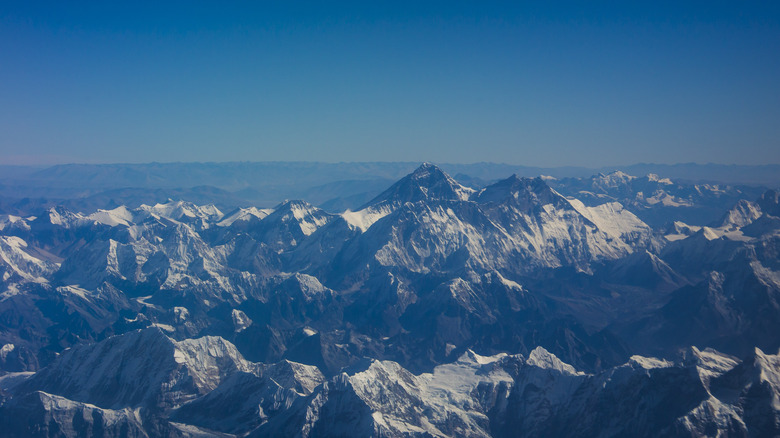The Tragic Story Of The 1996 Mount Everest Disaster
As Jon Krakauer writes in the introduction of "Into Thin Air," even attempting to climb the world's highest mountain "is an intrinsically irrational act — a triumph of desire over sensibility." It's one of the places in the world where everything can be done correctly, but with the flap of a butterfly's wings you might lose your life.
Unfortunately, everything wasn't done correctly during the summitting of Mount Everest on May 10, 1996. With the tourism industry at Mount Everest seeing a boom, there was a belief among some mountaineers that it was only a matter of time before a tragedy occurred on the mountain. Although the 1996 tragedy was the worst accident in the history of Everest at the time, it was supplanted by a 2014 avalanche, which claimed the lives of 13 people.
Many consider "summit fever" to be partly responsible for the 1996 disaster, especially since several climbers were willing to do whatever it took to get to the top and may have felt pressured to continue since others were doing so. And with increasing bottlenecks at Everest, care should be taken to ensure that a tragedy like the one in 1996 doesn't occur again. This is the tragic story of the 1996 Mount Everest disaster.
A little bit about Mount Everest
Between 50 to 60 million years ago the highest point in the world, Sagarmatha, also known as Chomolungma or Mount Everest, was created when the Indian and Eurasian tectonic plates collided. And the forces that pushed the rocks together are still going strong. Every year, Everest's summit rises by a quarter of an inch.
The first recorded people to climb Mount Everest were New Zealand mountaineer Edmund Hillary and Nepali-Indian Sherpa mountaineer Tenzing Norgay on May 29th, 1953. However, according to National Geographic, despite the fact that they simultaneously reached the summit, Hillary was knighted for the endeavor while Norgay "only received an honorary medal."
High Adventure Expeditions notes that there have been over 5,000 people to successfully climb Mount Everest. Two Nepalese Sherpa mountaineers, Lhakpa Tenzing Sherpa and Phurba Tashi Sherpa Mendewa, jointly hold the record for summiting Mount Everest more than any other person, having each climbed the mountain 21 times. However, climbing Mount Everest is an incredibly difficult feat, even for the most experienced mountaineers, and due to weather conditions, there's an extremely limited climbing season. One of the biggest dangers is the high altitude, and the area on Everest above 26,000ft is known as the "death zone." Spending too long in the death zone can cause "altitude sickness and even brain swelling."
The Everest climbing industry
After Norgay and Hillary submitted Mount Everest, the numbers of climbers saw an exponential increase. Between 1953 and the 1980s, less than 300 people had reached the summit, but in the 1990s alone almost 900 people climbed the mountain. In the 21st century, this number continued to swell. Overall, roughly 90% of all the attempted climbs have been successful.
ThoughtCo writes that in the 1990s, climbing Mount Everest turned into "a multi-million-dollar industry." Several companies advertised themselves as able to help even the most amateur climber reach the top of Everest. So amateur, that some climbers had never even been on a mountain before by their own admission. It wasn't cheap, costing between $30,000 and $65,000 per climber, but climbers felt that if they paid the $65,000, that they were "going to be taken to the top and back safely for that money."
According to The Washington Post, more and more crowds of people on Mount Everest often posed a problem, "sometimes preventing swift evacuations and cramming climbers together on perilous slopes." In 2003, Edmund Hillary himself told Time Magazine, "The commercialized trips and the overcrowding were what caused the tragedy [in 1996]. It was inevitable. I've been forecasting a disaster of that nature for some time. And it will happen again."
Mountain Madness and Adventure Consultants
In late March 1996, there were several groups getting ready to summit Mount Everest. Most of the groups were ascending from the Nepalese side of the mountain, while two other groups were climbing from the Tibetan side. There were groups from all over the world, including one American group that was there to make an IMAX film with filmmaker and climber David Breashears.
Two of the largest guided groups, coming in from the Nepalese side, were Adventure Consultants and Mountain Madness. Rob Hall, Mike Groom, and Andy Harris were the leaders of Adventure Consultants, while Mountain Madness was led by Scott Fischer, Anatoli Boukreev, and Neal Beidleman. According to ThoughtCo, Adventure Consultants included eight clients and seven Sherpa climbing guides and Mountain Madness had seven clients and eight Sherpa climbing guides. Jon Krakauer, who later went on to write the book "Into Thin Air" about his subsequent experience on the mountain, was part of Hall's Adventure Consultants group.
The first casualty
In mid-April, climbers started the acclimatization process, which involved spending longer and longer intervals in higher altitudes before returning back to Base Camp. According to ThoughtCo, over the course of the month, climbers made their way up to Camp III which was next to Lhotse Face, "a sheer wall of glacial ice" at 24,000ft.
On May 9th, the groups were scheduled to climb up to Camp IV, the highest camp at 26,000ft. But according to Mountain Zone, that day Chen Yu Nan, who was part of Gau Ming-ho's Taiwanese expedition, made the mistake of leaving his tent without attaching to his boots the necessary spikes for climbing ice. As a result, he fell down Lhotse Face into a crevasse. Chen was quickly pulled up from the crevasse and initially, "did not complain of pain and seemed to have suffered no serious injury," but the fall likely caused severe internal damage. As the morning progressed, it became clear to Chen that he wasn't feeling well so he told Gau he'd catch up with the group after resting for a few more hours.
Instead of resting, Chen decided to climb down from Camp III and was in a debilitated state when he was found by Sherpas coming down from the South Col path. Chen was carried a further 1,000ft down the mountain before he suddenly died. Even then, "members of the IMAX team climbed up from Camp II hoping to revive him, but it was too late."
Entering the Death Zone
On the way to Camp IV, almost everyone except for "a handful of elite climbers" needed to use oxygen to keep going. Camp IV lies at the beginning of the death zone, where the oxygen level is one-third that of sea level.
National Geographic reports that on the way up, the Adventure Consultants and Mountain Madness groups actually saw the IMAX team headed in the opposite direction. The IMAX team had decided that since the weather was "OK, but not great," it was better to head back to Camp II and wait for better conditions. The IMAX team almost started to doubt themselves, but the experienced climbers in the group had "seen summit fever before. If eight climbers head up, they pull 10 more with them. The mood is 'So-and-so's going today? Well, we should be going too.' But on Everest you've got to make your own decisions."
The other groups started arriving at Camp IV throughout May 9th, and although a storm came by during the afternoon, by evening the weather seemed to have cleared enough for the climb to continue.
Bottlenecking to the top
Mountain Madness, Adventure Consultants, and Gau's Taiwanese expedition set out at midnight on May 10th. According to ThoughtCo, every climber was given two spare bottles of oxygen for their climb. However, all of the oxygen was going to run out by five in the afternoon, so the climbers had to get down as quickly as possible once they submitted.
Unfortunately, the groups were affected by several delays. Although there had been a plan for some of the Sherpas to go ahead and set up lines of rope to help guide climbers through some of the more steep parts of the mountain, the fixed rope lines were not installed in advance. Setting up the ropes took an additional hour, and "many climbers were very slow due to inexperience."
According to Krakauer, at Base Camp, Adventure Consultants leader Hall had determined that climbers should turn-around by either 1PM or 2PM, regardless of whether they'd summited or not. However, a hard deadline was never set. And by 11AM, the summit was still three hours away. At 11:30AM, three of the climbers from Adventure Consultants "turned their backs on the summit" and decided to head back down the mountain. In the end, they seemed to make the better choice compared to the others.
Getting to the top of Mount Everest
The first batch of climbers was able to make it to the summit around 1PM, but people were summiting well past the 2PM turn-around time. According to ThoughtCo, Mountain Madness leader Fischer also didn't enforce a turn-around time, and "allow[ed] his clients to stay on the summit past 3PM." Mountain Zone notes that Gau also summited around 3PM. Fischer ended up being the last of his group to summit, and "no one questioned him because he was the leader and an experienced Everest climber." But even at that point, some of the climbers noticed that Fischer wasn't looking too great.
Adventure Consultants leader Hall and client Doug Hansen also ignored the turn-around time and didn't make it to the top of Mount Everest until 4PM. By that point, dark clouds had already appeared and snow was beginning to fall. This was especially treacherous since it meant that their tracks, which they needed in order to guide their way back down, would be covered up. As Krakauer notes, "the summit was really only the halfway point."
According to Sky Above Us, this was Hansen's second attempt to scale Everest, and it's possible that Hall was aware that "Hansen had spent his life savings on Hall's Everest expeditions, so may have been unduly swayed by Hansen not to firmly stick to the 2PM turnaround time."
A storm rolls in
The storm had started coming in around 3:30, and by 6PM it was a full-fledged blizzard "with gale-force winds," at a time when climbers were still trying to get down the mountain. Seventeen climbers were caught on the mountain as the blizzard roared around them and their oxygen supplies decreased. By 10PM, only half of the climbers who'd left that morning made it back. ThoughtCo writes that a group of climbers was able to make their way down the mountain, where they also found Beck Weathers. Weathers had been part of Hall's Adventure Consultants, but after having been struck by temporary blindness, he'd become stranded at 27,000ft.
According to The Guardian, Weathers had undergone a radial keratotomy before his Everest excursion in order to fix his short-sightedness. Once he got that high up though, "his adapted corneas changed shape, leaving him half-blind in the darkness." And although the bright sunlight helped close his iris, in the process, Weathers scratched his right eye with an ice crystal, leaving him able to see, but with no depth perception. Hall refused to allow Weathers to summit, and had assured him that he would accompany him down on his return. However, Hall had never made it back down.
The group was 200ft away from Camp IV, but the storm made it difficult to see, so the group — now made up of Weathers, Beidleman, Groom, Yasuko Namba, Sandy Pittman, Charlotte Fox, Lene Gammelgaard, Martin Adams, Klev Schoening — decided to wait out the storm.
Stranded at the top
Hall and Hansen found themselves stranded at Hillary Step during the blizzard. According to National Geographic, Hansen had collapsed, unable to go on, and Hall decided to stay with him. Hall got in touch with Base Camp, explaining the situation, and although his fellow guide Guy Cotter "plead[ed] with his old friend to leave [Hansen] and get down to the South Summit, if only to retrieve the oxygen bottles so he could start breathing gas and gain the strength to aid his client," Hall wouldn't leave Hansen alone.
ThoughtCo writes that they made attempts to descend, but during one of their unsuccessful attempts, Hansen lost his life. It's unclear what happened, since all Hall communicated over the radio was that "Doug was gone," and because Hansen's body was never found, no one knows if he succumbed to hypothermia or if he fell to his death. Hall also died, but severe weather kept rescuers from getting to Hall's body. It would take another 12 days before it was found by the IMAX team during their climb.
The day after Hansen died, Gau and Fischer were found 1,200ft above Camp IV by a group of Sherpas. Gau was suffering from severe frostbite, while Fischer was "unresponsive and barely breathing." Gau was guided down, but the Sherpas left Fischer behind, believing that he was "beyond hope." By the time Boukreev, one of Fischer's guides, went up to find Fischer, he had already died.
Left for dead twice
Although Beck Weathers had been found by the other climbers, when the storm cleared and they started heading for Camp IV, Weathers was one of three others who was "too incapacitated to move." Help was sent for the stranded climbers, but Boukreev was only able to help Fox and Pittman back, since another storm had made its way over. Weathers and Namba were left behind.
According to The Guardian, the next morning, they were found and examined by Canadian doctor Stuart Hutchinson. Both were declared barely alive and left for dead. But around four in the afternoon, Weathers came out of his hypothermic coma while news of his death was released. All That's Interesting writes that Weathers was somehow able to get himself together and stumble down the mountain to the camp.
Everyone was shocked: "Though his face was blackened with frostbite and his limbs were likely never going to be the same again, Beck Weathers was walking and talking." The following morning, the climbers thought that Weathers had died during the night, and almost left him again. Luckily, Weathers woke up in the nick of time and called out before his companions left him for dead once more.
What was the death toll of the 1996 Mount Everest disaster?
Some, like Gau and Weathers, were lucky enough to be rescued, although not without enduring some serious damage. Weathers lost his nose, his left fingers, and his right arm, and Gau lost his nose, fingers, and feet. But tragically, eight climbers ended up perishing during their attempt to summit Mount Everest on May 10, 1996. At the time, this was a record number of deaths in a single day.
Hall and Hansen perished at Hillary Step, and it's believed that Andy Harris died in an attempt to get them oxygen, since his body was never discovered, according to ThoughtCo. Unlike Weathers, Namba never awoke and froze to death above Camp IV, as did Fischer.
On the Tibetan side of the mountain, Tsewang Smanla, Tsewang Paljor, and Dorje Morup, who were part of one of the two groups ascending from the Tibetan side, also lost their lives during the storm. Paljor's body is believed to still be on Mount Everest, though it is known by the moniker "Green Boots." Unfortunately, it's not known exactly what happened to Smanla, Paljor, and Morup.
What went wrong?
The tragedy that occurred on Mount Everest on May 10, 1996 was the result of inexperience, a sunk-cost fallacy, bad luck with weather, human error, and a desire to profit. And in the end, group leaders like Hall and Fischer failed to predict and appropriately respond to the problems and delays that arose. Krakauer also claimed in his book that Fischer's decision not to have his guides, Boukreev and Lopsang Sherpa, carry oxygen led to their inability to assist climbers. However, there's no consensus on whether or not "a guide [with oxygen] will always be able to outperform a guide who does not use [oxygen]."
According to National Geographic, when the turnaround time passed, even those watching the climbers from camp with a telescope knew that it was time to go back. "Staring through the telescope, I muttered aloud, as if those anonymous specks could hear me, 'Guys, you left at midnight. It's two o'clock! It's going to be three or four before you get to the summit.' Then, as I watched the all but immobile procession, my mood darkened. 'Dudes, what are you doing? Wake up! Guys, turn around, turn around,' I urged."
Everything was already close as it was, and without the storm they "might have gotten away with it," but once the blizzard came it sealed the fates of everyone left on the mountain.
